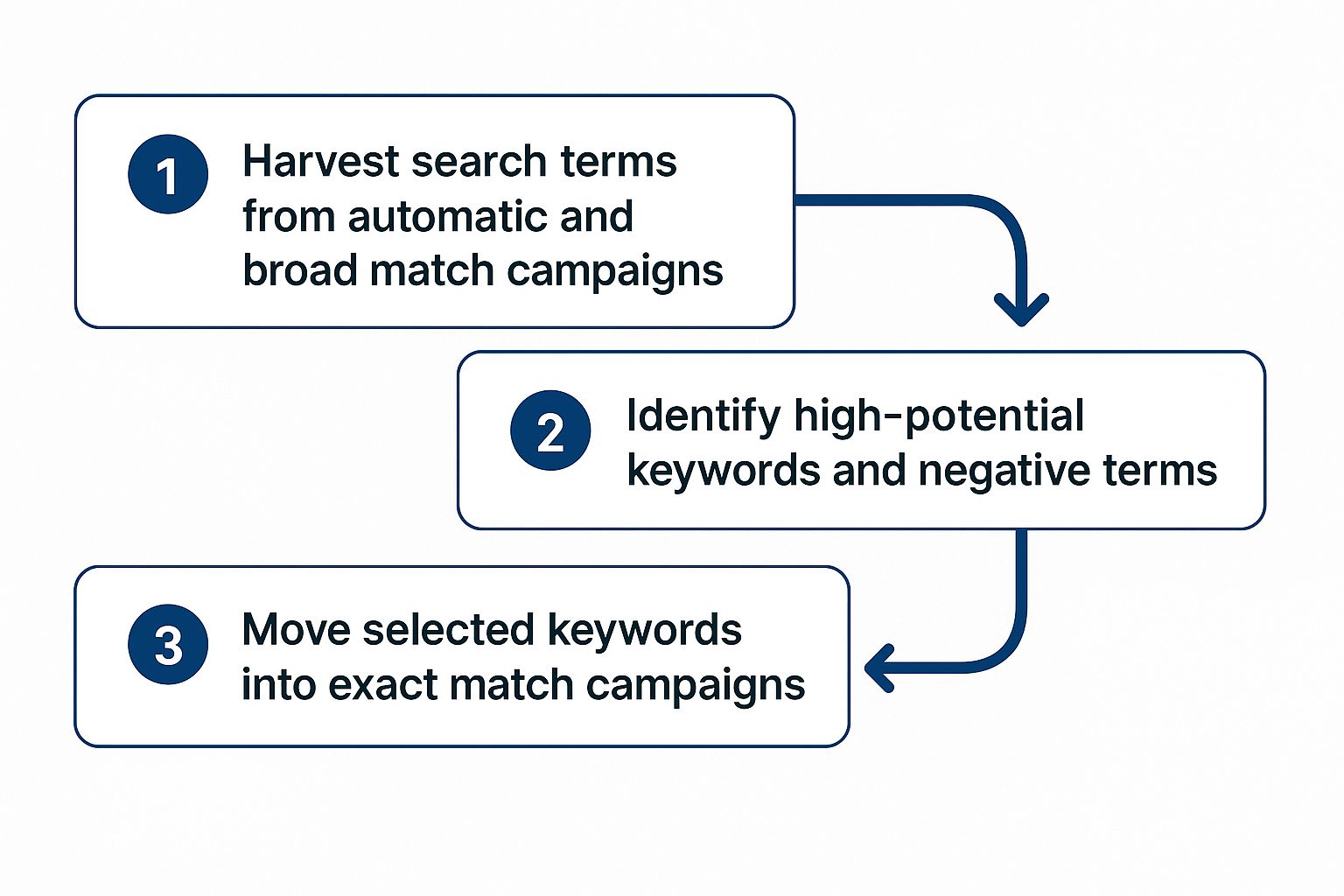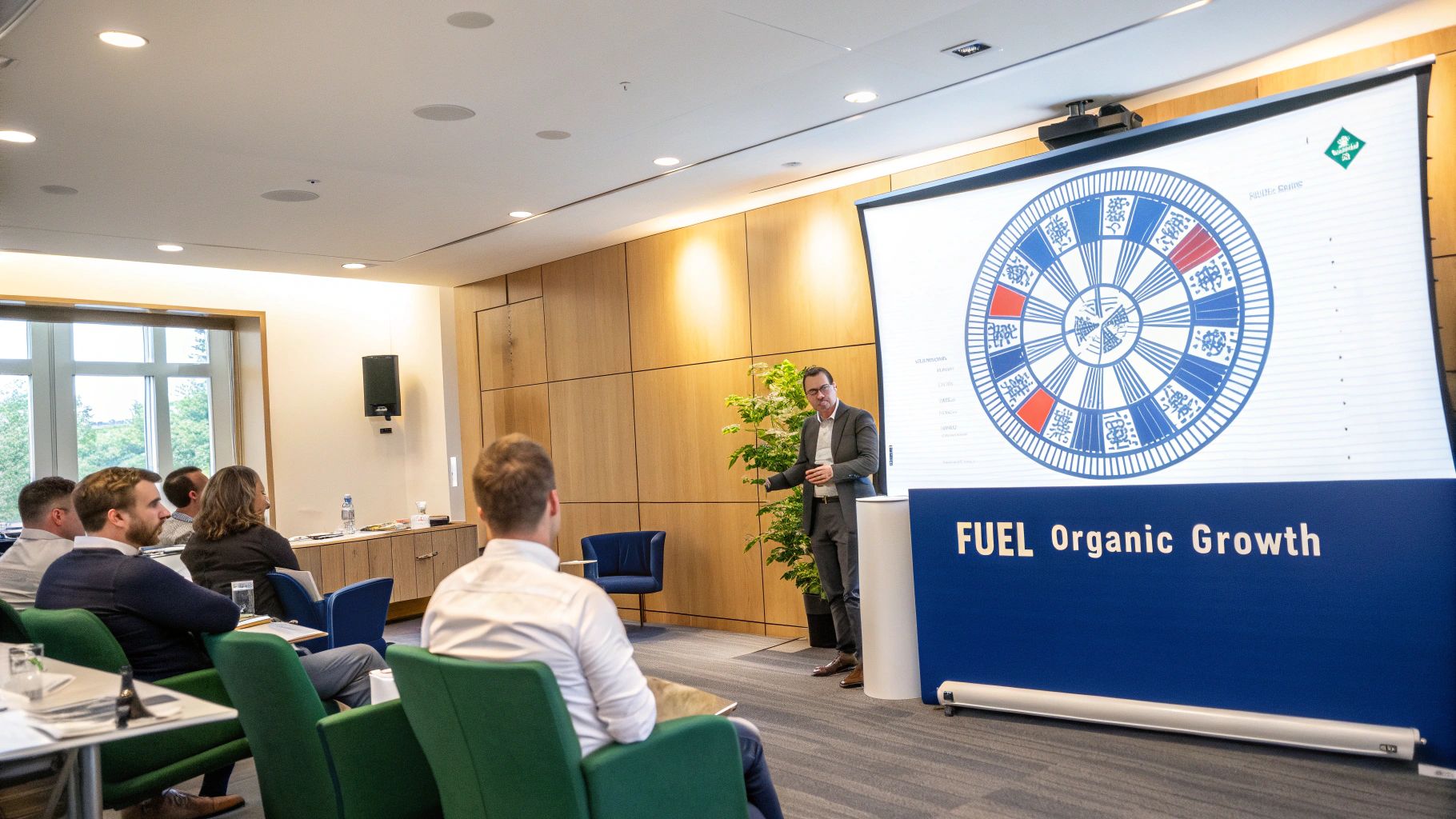Amazon Sponsored Ads Management That Drives Profit and Organic Rank
Unlock profitable growth with expert Amazon sponsored ads management. Learn data-driven strategies to scale campaigns and boost organic rank.

Effective Amazon sponsored ads management is about more than tweaking bids and budgets. That’s table stakes. For eCommerce leaders, true mastery lies in using PPC as a strategic lever for organic growth, profitability, and sustainable scale. It's the engine that powers your entire Amazon flywheel, turning paid visibility into dominant organic rankings and defensible market share.
While many see ads as a cost center, the top 1% of brands we work with treat it as a strategic investment. They understand that a dollar spent on a well-placed ad today can generate multiples in organic sales tomorrow.
Move Beyond Bids and Budgets
Let’s be direct: the old playbook of obsessing over Advertising Cost of Sale (ACoS) as a standalone metric is broken. It provides a narrow, often misleading, snapshot of performance. In today's hyper-competitive marketplace, a sophisticated approach is non-negotiable—one that integrates advertising directly into core business objectives, from product launches to market share defense.

This guide is for brand leaders ready to move beyond vanity metrics. We'll outline how to architect a data-driven ad strategy that doesn’t just capture incremental ad sales, but systematically lifts your organic presence and builds a brand with lasting value.
The Shift from Expense to Investment
Viewing ad spend as a pure expense is the fastest way to cap your growth potential. The real power is unlocked when you use paid placements as a catalyst for the A9 algorithm. A well-executed ad campaign drives sales velocity—a primary ranking signal for Amazon. More sales lead to higher organic keyword rankings, creating a powerful, self-sustaining cycle of visibility and sales.
This "flywheel effect" is what separates brands that merely survive on Amazon from those that dominate their categories. Instead of asking, "What's my ACoS?", the more intelligent question for a leader is, "How is my total ad investment impacting my total sales and market share?" This shifts the focus to a metric that reflects true business health: Total ACoS (TACoS).
The Takeaway: Your Amazon advertising strategy cannot exist in a vacuum. It must be a core component of your growth plan. The objective isn't just to win paid clicks; it's to leverage that paid traffic to fuel the long-term, highly profitable engine of organic sales.
Architecting for Sustainable Scale
A winning Amazon Sponsored Ads strategy requires a foundation built for profitability and scale. This means moving beyond generic auto-campaigns and implementing a structure with intent. The most successful strategies are always built on three core principles:
- Clear Objectives: Every campaign must have a defined purpose. Is it for launching a new product? Defending brand equity? Conquesting a competitor? Assign it a job.
- Data-Driven Decisions: Gut feelings are liabilities. Every decision—from keyword selection to bid adjustments—must be rooted in performance data.
- Profit-Aligned Metrics: Stop chasing impressions. Success must be measured by its impact on the bottom line. This is non-negotiable.
When you build your strategy around these pillars, advertising transforms from a reactive expense into a proactive growth driver. This guide provides the blueprint.
Build Your Campaigns For Profit And Scale
A disorganized campaign structure is the fastest way to incinerate your ad budget. Too many brands launch a generic automatic campaign and hope for the best. That’s not a strategy; it’s a gamble. To manage your Amazon sponsored ads effectively, you need an architecture built for purpose, clarity, and profitability from day one.
This isn't about arbitrary organization—it's about control. A logical structure enables precise budget allocation, clear performance analysis, and agile, data-backed decision-making. Without it, you’re flying blind in an increasingly crowded airspace. Amazon's ad revenue soared to $11.8 billion in Q1 2024, a 24% year-over-year increase, signaling intensified competition. In this environment, a disciplined campaign structure is your primary competitive advantage. For a broader view, you can explore more Amazon advertising statistics.
A Blueprint For Strategic Campaign Structure
Forget one-size-fits-all. A high-performance campaign architecture is segmented by objective. This means creating distinct campaigns for different goals, match types, and product lifecycle stages. A new product launch requires an aggressive discovery strategy; a mature bestseller demands a focus on profit maximization and brand defense.
This table outlines a proven framework for organizing campaigns to deliver maximum control and clear performance insights.
Strategic Campaign Structure Blueprint
| Campaign Group | Campaign Type Example | Primary Goal | Key Metrics |
|---|---|---|---|
| Discovery | Auto & Broad Match | Mine for new, high-converting customer search terms and profitable ASIN targets. | Clicks, Search Term Report, Cost-Per-Acquisition |
| Performance | Exact & Phrase Match | Drive profitable sales from proven, high-intent keywords and targets. | ACoS, TACOS, Conversion Rate, ROAS |
| Brand Defense | Branded Exact Match | Protect brand equity from competitors and capture high-intent, bottom-funnel traffic. | Impression Share, Cost-per-click (CPC) |
| Conquesting | Competitor ASIN & Keyword Targeting | Capture market share by targeting competitor listings and branded terms. | Clicks, Sales, New-to-Brand Metrics |
By segmenting campaigns this way, you eliminate guesswork and start making strategic decisions based on clean, unblended data. Each campaign group has a distinct purpose, enabling precise budget allocation and accurate success measurement.
Here’s the actionable breakdown:
- Discovery Campaigns (Auto & Broad): These are your intelligence-gathering operations. Run one automatic and one broad match campaign per product group. Their sole mission is to uncover new, relevant search terms and profitable ASINs.
- Performance Campaigns (Exact & Phrase): This is where you capitalize on intelligence. Once Discovery campaigns identify converting keywords and ASINs, you "graduate" them into these tightly controlled campaigns for profitable scaling.
- Branded Campaigns (Your Brand Name): This is non-negotiable. Isolate all keywords containing your brand name into a dedicated campaign. This allows you to defend against competitors and accurately measure the performance of brand-loyal customers.
- Competitor Campaigns (Their Brands & ASINs): This is your offensive strategy. Target specific competitor brand names and their top-selling ASINs to strategically siphon their customers. These campaigns can tolerate a higher ACoS as they are an investment in market share acquisition.
Pro Tip: Implement a strict, consistent naming convention from day one. A format like
[Product Line] - [Strategy] - [Match Type](e.g., "ProteinBar - Competitor - Exact") ensures your reporting is clean and saves countless hours of data archeology.
Why Isolating Your Branded Keywords Is Critical
A common, costly mistake is lumping branded keywords in with general performance campaigns. This contaminates your data and leads to poor decision-making.
Customers searching for your brand name have high purchase intent. Their conversion rates are exceptional and their ACoS is incredibly low. When you mix these high-performers with non-branded, prospecting keywords, you get a blended ACoS that looks artificially healthy. This false confidence masks underperforming keywords, tricking you into wasting budget on unprofitable terms because the strength of your brand is hiding the weakness.
Creating a separate Branded Campaign achieves two critical objectives:
- Accurate Measurement: You can finally see the true performance of your non-branded advertising, which is essential for intelligent optimization and scaling.
- Brand Defense: It guarantees you own the top ad spot for your brand name, preventing competitors from poaching your most valuable, ready-to-buy customers at the last second.
This structural discipline is the foundation of professional Amazon PPC management. It elevates your ad account from a chaotic cost center to a predictable, scalable growth engine. While it requires more initial effort, the long-term payoff in control, clarity, and profitability is immense.
Turn Search Data Into Your Secret Weapon
Forget expensive, third-party keyword tools. Your most profitable keywords are already hiding in your own advertising data.
Top-tier Amazon sponsored ads management isn't about finding a magic keyword list. It’s about building a systematic process to listen to what customers are telling you through their search queries. This is where real performance gains are made: continuous keyword and ASIN harvesting.
Your automatic and broad match campaigns are discovery engines. Their primary job isn't immediate profitability, but to cast a wide net and capture the exact, unfiltered language real shoppers use to find your products. This data is a goldmine, but only if you have a disciplined process for mining it.
Mining Your Search Term Reports
The Amazon Search Term Report is the single most valuable asset in your PPC toolkit. It shows the literal queries customers typed before clicking your ad. This isn't a one-time analysis; it's a perpetual cycle of identifying what works and eliminating what doesn’t.
This process transforms raw search data into a high-performance campaign structure.

This workflow is the core of any robust optimization strategy. You are constantly reallocating budget away from speculative spend and onto proven, high-converting targets.
It boils down to two critical, recurring actions:
Promote High-Performers: Systematically scan your reports for search terms that have generated at least one sale at or below your target ACoS. These are your proven winners. Graduate these exact terms into your "Performance" campaigns as exact match keywords. This allows you to bid on them with confidence and control spend with precision.
Negate Budget Drains: Equally important is identifying terms that waste budget. Look for search terms with a statistically significant number of clicks but zero sales. These are budget leaks. Add these irrelevant terms as negative exact match keywords to your discovery campaigns to prevent future wasted spend. This simple housekeeping has a direct and immediate impact on profitability.
Key Insight: Don't just analyze ACoS during harvesting. A search term with a high click-through rate (CTR) but no sales is a valuable diagnostic tool. It often indicates a mismatch between your ad copy/creative and your product detail page, signaling a conversion optimization opportunity.
Advanced Targeting With ASINs
Keywords are only half the battle. Your discovery campaigns also reveal which competitor and complementary product pages your ads are converting on. This is Product Attribute Targeting (PAT), and it's a direct line to capturing market share.
When a specific ASIN appears in your Search Term Report with a conversion, it’s a clear signal: shoppers viewing that product are interested in yours.
Here’s the strategic play:
Competitor Conquesting: A shopper clicks your ad on a direct competitor's page and buys from you. This is a high-value conversion. Immediately add that competitor's ASIN to a dedicated "Conquesting" campaign. You can now aggressively target shoppers moments away from purchasing from a rival.
Strategic Cross-Sells: You may also find conversions on pages for complementary products—your coffee filters converting on a coffee maker's detail page. Targeting these ASINs allows you to create a logical bundle in the customer's mind, driving incremental sales you would have otherwise missed.
This cycle of continuous refinement is what builds scalable growth on Amazon. For a deeper tactical view, our guide on how to use search terms on Amazon breaks this down step-by-step. The goal is to transform your campaigns from static entities into an intelligent system that becomes more efficient with every click and sale.
Master Your Bidding and Budget Allocation
Winning at Amazon sponsored ads management requires more than just keyword selection. It's about deploying capital with data-driven precision. Amazon’s generic bid suggestions are merely a starting point. True performance comes from tying your bidding and budget strategy directly to your business goals.
This is where financial acumen meets marketing. The objective isn't just to spend money—it's to invest it where it will generate the highest return, whether that’s launching a new product or maximizing profit on a mature one. This requires a shift from reactive performance-chasing to proactive financial planning for your ad spend.
Setting the Right Targets
Before setting a single bid, you must define what a "win" looks like. That starts with calculating your break-even Advertising Cost of Sale (ACoS)—the point at which ad spend equals your product's profit margin. Any ACoS below this threshold is profitable.
However, your target ACoS (TACoS) should not be a static, account-wide number. It must be a flexible, strategic lever tied to a specific objective.
- Launch Phase: For a new product, you might set a target ACoS higher than your break-even point. Here, the goal is not immediate profit but aggressive sales velocity to gain market traction and influence organic ranking. It’s an investment in future organic sales.
- Profitability Phase: For a mature, established product, your target ACoS should be set comfortably below your break-even point. The objective shifts to maximizing cash flow and return on ad spend (ROAS).
Key Takeaway: Your ACoS target is a strategic lever, not a static KPI. Assign a unique target for each product based on its lifecycle stage and business objective. For a deeper dive into this crucial metric, learn more about calculating and using ACoS on Amazon in our detailed guide.
Choosing Your Dynamic Bidding Strategy
Amazon's dynamic bidding strategies automatically adjust your bids based on the likelihood of conversion. Selecting the right one is critical to maximizing budget efficiency.
- Down Only: This is the most conservative and safest option. Amazon will only decrease your bid (up to 100%) if a conversion is deemed unlikely. It's ideal for campaigns where maintaining strict profitability is the primary goal.
- Up and Down: This is a more aggressive strategy. Amazon can increase your bid (up to 100% for top-of-search) for placements with a higher likelihood of converting. Reserve this for new product launches or strategic campaigns where gaining visibility and sales velocity for key terms outweighs the need for immediate profit.
Our recommendation: Default to "Down only" for your established, profit-focused campaigns. Use "Up and down" surgically for short-term, high-priority initiatives, but monitor cost-per-click and ACoS closely.
Strategic Budget Allocation
An even budget split across all campaigns is a recipe for inefficiency. You must be agile, directing capital to campaigns delivering the best results. This requires active management, not a "set it and forget it" mindset. Think like a portfolio manager allocating capital to the highest-performing assets.
Utilize Amazon's Portfolios feature to group campaigns by product line, strategy ("Launch," "Brand Defense"), or any logical business unit. This provides a high-level performance view and allows you to set budget caps for entire groups, preventing a single rogue campaign from derailing your monthly budget.
With Amazon's ad revenue soaring past $50 billion annually and expected to hit nearly $60 billion by the end of 2024, the platform is more competitive than ever. Brands are investing heavily, making disciplined budget management a critical differentiator.
To gain a true competitive edge, look beyond historical data. Understanding how AI improves KPI forecasting accuracy can provide the data-backed confidence needed to allocate spend proactively. By establishing a weekly rhythm of reviewing performance and reallocating budget from underperformers to winners, you create a self-optimizing system that continuously improves your overall return.
Use PPC To Fuel Your Organic Growth
This is the strategic linchpin. We must stop viewing Amazon ads as a simple transactional expense—spend X, get Y in ad sales. That is a tactical, not a strategic, mindset. The brands that truly dominate Amazon see their ad spend as an investment in a far more valuable asset: long-term, sustainable organic growth.
Smart Amazon sponsored ads management is about architecting a system that turns paid clicks into a catalyst for organic dominance.

This is the Amazon Flywheel in action. Every sale generated by a sponsored ad sends a powerful signal to Amazon's A9 algorithm, validating your product's relevance for that specific keyword. The more signals you send, the higher Amazon promotes your product in the organic search results.
This creates a powerful, self-reinforcing cycle. Ads drive sales, which improves organic rank, which drives more sales without an associated ad cost. Your ad spend transforms from a short-term expense into a long-term investment in your brand's digital shelf space.
From ACoS to TACoS: The Metric That Actually Matters
The industry has long been fixated on ACoS (Advertising Cost of Sale). While useful for measuring campaign-level efficiency, it tells only half the story. ACoS compares ad spend only to ad-driven sales, completely ignoring the significant impact advertising has on organic revenue.
This is why Total Advertising Cost of Sale (TACoS) is the metric that should be on every brand leader's dashboard.
TACoS measures your total ad spend against your total sales (paid + organic). It provides a holistic view of your advertising's leverage on the entire business. If your TACoS is decreasing over time while total sales are growing, it is the ultimate sign of a healthy, scaling brand on Amazon. It means your ad investment is successfully building an organic foundation that requires progressively less paid support to maintain momentum.
This mindset shift is critical. Focusing on TACoS moves the conversation from "How do I cut my ACoS?" to "How can my ad investment grow my total market share and profitability?" It is the difference between tactical cost-cutting and strategic brand building.
Pushing Keywords Over the Tipping Point
How do you operationalize the flywheel concept? Through surgical, data-driven ad spend. The greatest ROI comes from identifying keywords where your products are on the cusp of an organic breakthrough.
The highest-leverage opportunity lies with keywords where you already rank on the bottom of page one or the top of page two—typically organic positions 5 through 15. Your product is at a tipping point. Amazon already deems it relevant; it just needs an injection of sales velocity to push it into the top positions where the majority of clicks and sales occur.
This is where you deploy a strategic ad spend surge. Here is the playbook:
- Identify "Striking Distance" Keywords: Use a rank tracking tool to find high-volume, relevant keywords where you rank in positions 5-15.
- Launch a Hyper-Focused Campaign: Create a new Sponsored Products campaign targeting only these keywords using exact match for maximum control.
- Bid for Top of Search: This is not the time for conservatism. Use the "Up and down" bidding strategy and set aggressive bids with a top-of-search placement modifier. The goal is sales velocity, not a low ACoS.
- Monitor Organic Rank: Track your organic rank for these keywords daily. As ad-driven sales accumulate, your organic position should climb. Once you secure a stable position in the top 3-5 spots, you can gradually reduce the aggressive ad spend and let organic momentum take over.
This targeted strategy is one of the most effective ways to learn how to improve Amazon ranking, converting a precise ad investment into a lasting organic asset.
This strategic thinking is more critical than ever. As highlighted in this breakdown of Amazon's growing ad business milestones on nasdaq.com, the platform's reliance on ad revenue means brands without a sophisticated playbook will be left behind. Using PPC to build your organic foundation is the pinnacle of advanced Amazon advertising—playing the long game to build a brand that wins for years to come.
Common Questions About Amazon Ads Management
Even the most seasoned eCommerce leaders have questions when it comes to maximizing their return on Amazon's ad platform. Let's address the most critical challenges facing brands in Amazon sponsored ads management.
How Long Does It Take To See Real Results From Amazon PPC?
You will see data—clicks and impressions—within hours. Do not mistake this activity for results. The first 2-4 weeks of any new campaign architecture should be treated as a pure data-gathering phase. You are collecting the market intelligence required to make informed optimization decisions.
Tangible business results—a positive, sustainable shift in sales, profitable ACoS, and improved organic rank—typically begin to materialize after 60-90 days of consistent, disciplined management. This is not a "get rich quick" channel; it's about methodically building a long-term, profitable asset for your brand.
What Is A Good ACoS For My Amazon Ads?
This is the most common question, and the answer is always: it depends. There is no universal "good" ACoS. The only number that matters is your break-even ACoS, which is determined by your product's profit margin. Any ACoS below that figure is profitable on a per-sale basis.
Your target ACoS must be a strategic decision, not an arbitrary benchmark.
- For a new product launch: A high ACoS, potentially above break-even, may be a sound investment to drive initial sales velocity and secure market share.
- For a mature bestseller: The goal shifts to profit maximization. Here, your target ACoS should be well below your break-even point to generate healthy cash flow.
Your target ACoS is not a static, account-wide figure. It is a dynamic lever, adjusted for each product based on its specific business objective at that time.
Should I Use Sponsored Products, Brands, Or Display Ads?
The answer is you should strategically use all three. They are not mutually exclusive; they each play a distinct and vital role in a full-funnel advertising strategy.
Think of it as a coordinated offensive. Sponsored Products are your frontline infantry. They target high-intent shoppers via keywords and consistently deliver the highest conversion rates, forming the foundation of your strategy.
Next, deploy Sponsored Brands. These are your air support, building brand awareness at the top of the search results page and defending your branded search terms from competitor encroachment.
Finally, leverage Sponsored Display as your special operations. Use its powerful retargeting and audience-targeting capabilities to re-engage shoppers who viewed but didn't purchase, and to conquest customers directly on your competitors' product pages. A truly dominant strategy integrates all three ad types seamlessly.
If you are looking to build this kind of integrated, performance-focused strategy, exploring a professional service like Full Circle Agency's Amazon Ads management approach can provide valuable insights.
At Headline Marketing Agency, we don't just manage ad spend—we build performance-driven advertising systems that fuel sustainable growth and long-term profitability. Our approach moves beyond surface-level metrics to architect a dominant and defensible brand presence on Amazon.
Wollen Sie Ihre Amazon PPC-Performance aufs nächste Level bringen?
Lassen Sie Ihre Amazon PPC-Kampagnen professionell analysieren und entdecken Sie neue Wachstumsmöglichkeiten.